Black architects are rare. This program plans to change that — from fastcompany.com by Nate Berg
Black Architects in the Making exposes students to architecture starting in elementary school.
Excerpt:
There should be many more Black architects in the U.S. Based solely on Census figures, about 14% of the U.S. population identifies as Black, but in a profession of more than 122,000 registered architects, the number of Black architects is far from proportional.
“We would anticipate something in the region of 17,000 architects would identify as Black. In fact, we have less than 2,500,” says Craig Aquart, a principal at the Miami architectural firm, MC Harry Associates. That comes out to just about 2%.
This disparity is what led Aquart to help create Black Architects in the Making (BAM), a program aimed at bringing architectural exposure to Black students from elementary school to high school in the Miami region.


























